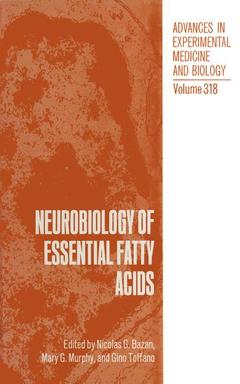Neurobiology of Essential Fatty Acids, Softcover reprint of the original 1st ed. 1992 Advances in Experimental Medicine and Biology Series, Vol. 318
Langue : Anglais
Coordonnateurs : Bazan Nicolas G., Murphy Mary G., Toffano Gino

It is increasingly evident that polyunsaturated fatty acids (PUFA), which in the past were often believed to be mere components of cellular membranes of neural tissue, are actually major determinants of the functional properties of neural cells and are intimately involved in brain disease processes. The two families of PUF A, which are derived from the essential polyenes, linoleic (18:26) and a-linolenic (18:33) acids, constitute a major proportion (-30%) of the total fatty acids esterified to brain phospholipids. Each family is distributed in membranes in a highly specific manner with respect to brain region, cell type, and position within each of the phosphoglycerides. Unlike their behavior in other organs, the PUF A components of brain turn over slowly and are relatively resistant to dietary modification. Their unique distribution and stability suggest that they play an important role in determining the functional properties of neural cells. However, until recently very little was known regarding the precise nature of their involvement.
Phospholipases A2: Properties And Modulation.- The Induction of Cellular Group II Phospholipase A2 By Cytokines And Its Prevention By Dexamethasone.- Brain Phospholipases and Their Role In Signal Transduction.- Characteristics And Possible Functions of Mast Cell Phospholipases A2.- Extracellular Phospholipase A2.- Ischemic Brain Damage: Focus on Lipids and Lipid Mediators.- Cell Signaling and Essential Fatty Acids: Cross-Talk Between Receptors And Messengers.- Reciprocal Regulation of Fatty Acid Release In The Brain by Gaba And Glutamate.- Nmda Receptor-Mediated Arachidonic Acid Release In Neurons: Role In Signal Transduction and Pathological Aspects.- Non-Eicosanoid Functions of Essential Fatty Acids: Regulation of Adenosine-Related Functions In Cultured Neuroblastoma Cells.- Contributions To Arachidonic Acid Release In Mouse Cerebrum By The Phosphoinositide-Phospholipase C And Phospholipase A2 Pathways.- Modulation of Arachidonic Acid Metabolism In Cultured Rat Astroglial Cells by long-chain n-3 fatty acids.- Modulation Of Glutamate Release From Hippocampal Mossy Fiber Nerve Endings By Arachidonic Acid And Eicosanoids.- Metabotropic Glutamate Receptors And Neuronal Toxicity.- Metabolites Of Essential Fatty Acids And Other Membrane-Derived Second Messengers In Cell Signaling.- A role for the arachidonic acid cascade in fast synaptic modulation: ion channels and Transmitter uptake systems as target proteins.- Aplysia californica contains a novel 12-lipoxygenase which generates biologically active products From arachidonic acid.- Essential fatty acid deficiency in cultured sk-n-sh Human neuroblastoma cells.- Phospholipid Metabolism And Second Messenger System After Brain Ischemia.- Dietary Supply Of Essential Fatty Acids, Synaptogenesis, and Photoreceptor Membrane Biogenesis.- Impact of dietary fatty acid balance on membrane Structure and function of neural tissues.- Structural and Functional Importance of Dietary Polyunsaturated Fatty Acids In The Nervous System.- Long and very long polyunsaturated fatty acids of retina and spermatozoa: The whole Complement of polyenoic fatty acid series.- Phospholipid Metabolism In Rat Intestinal Mucosa After Oral Administration of Lysophospholipids.- Carbachol-Stimulated Release of Arachidonic Acid and Eicosanoids From Brain Cortex Synaptoneurosome Lipids of Adult and Aged Rats.- Carbachol-Induced Stimulation Of Inositol Phosphates, Arachidonic Acid and Prostaglandin F2?In Rabbit Retina.- Induced and Spontaneous Seizures In Man Produce Increases In Regional Brain Lipid Detected by In Vivo Proton Magnetic Resonance Spectroscopy.- Network of Signal Transduction Pathways Involving Lipids: Protein Kinase C-Dependent And -Independent Pathways.- Essential Fatty Acids, Excitable Membrane Phospholipids, And Pathophysiology.- Conservation of Docosahexaenoic Acid In The Retina.- Docosahexaenoic Acid Uptake and Metabolism In Photoreceptors: Retinal Conservation By An Efficient Retinal Pigment Epithelial cell-mediated recycling process.- Essential Fatty Acids and Neurodevelopmental Disorder.- Regulation of Arachidonic Acid Metabolism In The Perinatal Brain During Development And Under Ischemic Stress.- Interactions of Phospholipids And Free Fatty Acids With Antidepressant Recognition Binding Sites In Rat Brain.- Very long-chain Fatty Acids in Peroxisomal Disease.- Long Chain Omega 3 Polyunsaturates In Formula-Fed Term Infants.- Severe Changes In Polyunsaturated Fatty Acids In The Brain, Liver, Kidney, and Retina In Patients With Peroxisomal Disorders.- Degradation of Phospholipids And Protein Kinase CActivation For The Control Of Neuronal Functions.- Essential Fatty Acids and Excitable Membrane Phospholipids.- Disposition Kinetics of Phospholipid Liposomes.- Behavioral And Morpho-Functional Correlates of Brain Aging: A Preclinical Study With Phosphatidylserine.- Receptor Coupling To Phosphoinositide Signals.- Diacylglycerol Composition And Metabolism In Peripheral Nerve.- Contributors.
Date de parution : 10-2012
Ouvrage de 444 p.
15.6x24.4 cm
Thèmes de Neurobiology of Essential Fatty Acids :
Mots-clés :
GABA; Glutamat; behavior; biology; brain; kinetics; lipide; neurobiology; pathophysiology; physiology; receptor; tissue
© 2024 LAVOISIER S.A.S.



